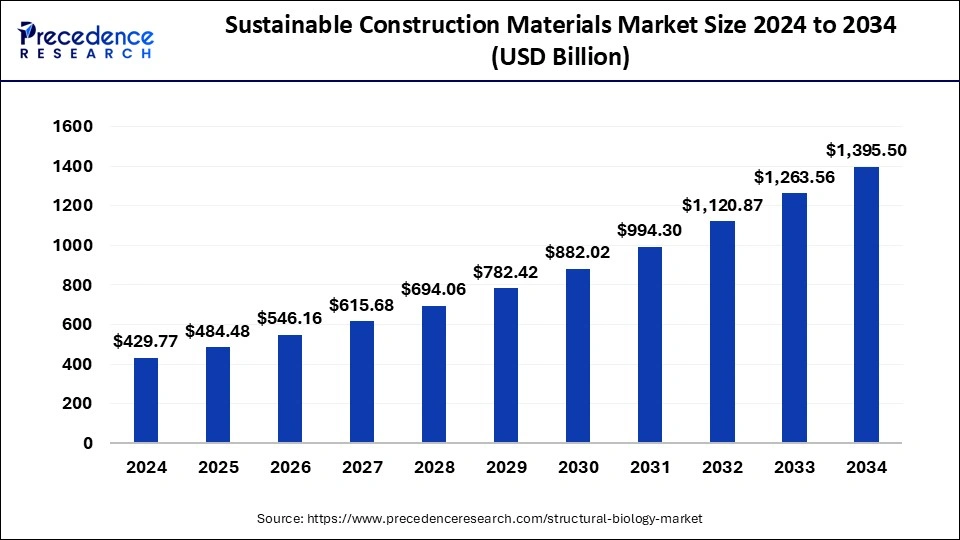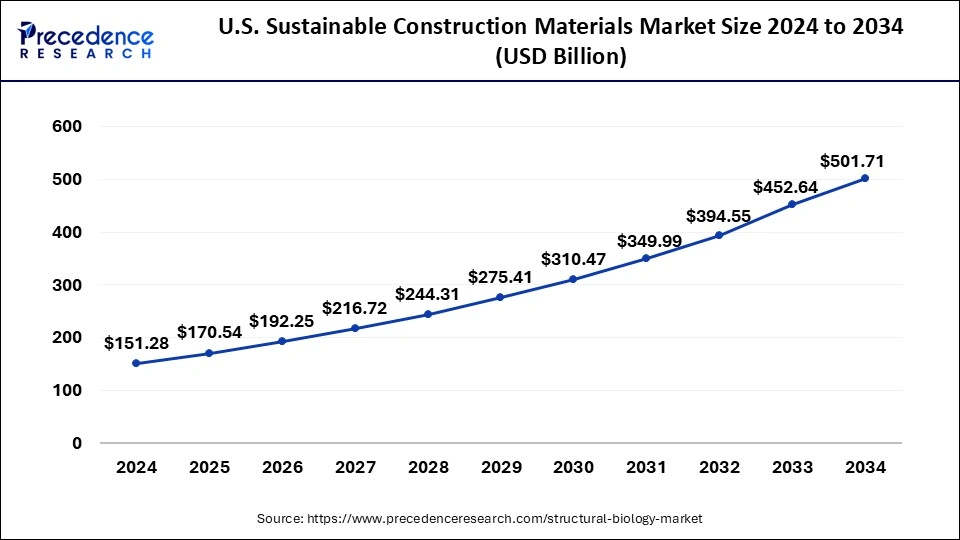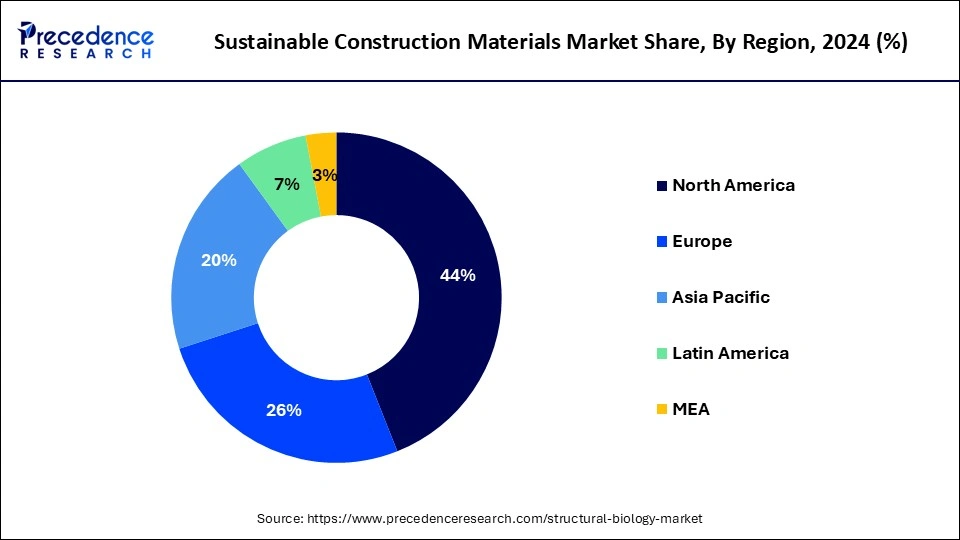January 2025
The global sustainable construction materials market size is calculated at USD 484.48 billion in 2025 and is forecasted to reach around USD 1395.50 billion by 2034, accelerating at a CAGR of 12.50% from 2025 to 2034. The North America sustainable construction materials market size surpassed USD 189.10 billion in 2024 and is expanding at a CAGR of 12.50% during the forecast period. The market sizing and forecasts are revenue-based (USD Million/Billion), with 2024 as the base year.
The global sustainable construction materials market size was estimated at USD 429.77 billion in 2024 and is predicted to increase from USD 484.48 billion in 2025 to approximately USD 1395.50 billion by 2034, expanding at a CAGR of 12.50% from 2025 to 2034. Customers' growing knowledge of environmental concerns is driving the need for sustainable and environmentally friendly construction materials, which can boost the market.

The U.S. sustainable construction materials market size was exhibited at USD 151.28 billion in 2024 and is projected to be worth around USD 501.71 billion by 2034, poised to grow at a CAGR of 12.74% from 2025 to 2034.

North America dominated the sustainable construction materials market in 2024. The use of sustainable building materials is required in North America due to strict building requirements and environmental laws aimed at minimizing environmental effects. Numerous efforts from the federal, state, and municipal governments encourage green building methods and provide financial incentives for the use of sustainable building materials. For example, tax credits, grants, and subsidies are only a few of the financial incentives that North American governments provide to promote the use of sustainable building materials.
The use of sustainable materials is accelerated by initiatives like ENERGY STAR and LEED (Leadership in Energy and Environmental Design), which certify and honor green buildings. North American consumers are becoming more conscious of environmental concerns and the advantages of living sustainably, which is driving up demand for environmentally friendly building materials.

Europe held a significant share of the sustainable construction materials market in 2024. Europe has some of the world's strongest building laws and environmental restrictions, requiring the use of sustainable materials in construction. The Energy Performance of Buildings Directive (EPBD) and the Circular Economy Action Plan are two examples of policies and directives that the European Union (EU) has put into place to encourage the use of sustainable building materials. In order to encourage the use of sustainable building materials, European governments provide a variety of financial incentives, such as grants, subsidies, and tax breaks.
By certification and acknowledgment, programs such as BREEAM (Building Research Establishment Environmental Assessment Method) promote the use of sustainable materials. European customers are very concerned about the environment and want eco-friendly building supplies and methods. The need for sustainable building is rising as there is a growing desire for energy-efficient and sustainable housing.
Asia Pacific is expected to grow at the highest CAGR during the forecast period. Asia Pacific is rapidly becoming more urbanized, and in order to accommodate the expanding population, substantial infrastructure, and real estate development are required. Many large-scale infrastructures and building projects that use more and more sustainable materials are located throughout the region. The construction is expanding as a result of robust economic expansion in nations like China, India, and Southeast Asia. As economies grow, so do public and private investments in sustainable building practices.
The stricter environmental laws are being implemented by governments in the Asia Pacific area in an effort to decrease pollution, lower carbon footprints, and encourage the use of sustainable materials. Green building techniques and the usage of eco-friendly materials are being promoted by national and municipal governments through the creation of projects and incentives. Due to the region's serious environmental problems, such as pollution and the effects of climate change, sustainability is important.
The sustainable construction materials market refers to sustainable building materials as those that, from the point of manufacture to the point of disposal, have the least negative effects on the environment. These products are intended to encourage environmental stewardship and lessen the total carbon footprint of building projects. In order to achieve more environmentally friendly and responsible building practices and contribute to the overall sustainability of the built environment, it is imperative that sustainable construction materials be used. The sustainable construction materials market is fragmented, with multiple small-scale and large-scale players.
| Report Coverage | Details |
| Market Size by 2034 | USD 1395.50 Billion |
| Market Size in 2025 | USD 484.48 Billion |
| Growth Rate from 2025 to 2034 | CAGR of 12.50% |
| Largest Market | North America |
| Base Year | 2024 |
| Forecast Period | 2025 to 2034 |
| Segments Covered | Type, End-user, and Regions |
| Regions Covered | North America, Europe, Asia-Pacific, Latin America, and Middle East & Africa |
Rising trend towards green building
The rising trend towards green building can boost the sustainable construction materials market. Sustainability, energy economy, and environmental responsibility are highlighted in green building. The need for sustainable building materials inevitably rises as more developers, architects, and builders embrace green building techniques. The environmental problems and the effects of development on the environment are becoming more well-known to consumers. The preference for green buildings that results from this increasing knowledge raises the need for sustainable building materials.
High cost of production
The high cost of production may slow down the sustainable construction materials market. The high production cost results in higher prices for sustainable construction materials, which makes them less affordable for builders and contractors. Also, sustainable construction materials may face stiff competition from traditional materials or lower-cost alternatives.
Production of advanced sustainable construction materials
The production of advanced sustainable construction materials is an opportunity for the sustainable construction materials market. Advanced sustainable construction materials offer good performance characteristics, including durability, strength, and sustainability, compared to traditional materials. Also, there has been an improvement in investment in research and development in technical advancements in sustainable construction materials. The technical advancement in sustainable construction materials includes innovation in material science manufacturing techniques and automation by making advanced sustainable construction materials more cost-effective.
Rising learning programs
The rising learning programs can be an opportunity to boost the sustainable construction materials market. The learning programs are intended for professionals from various fields in the construction industry, such as architects, specifiers, engineers, design consultants, and project managers, who want to gain more knowledge about how to integrate lower-carbon building materials into the design phase from the beginning can have a substantial positive impact on sustainability.
The bamboo segment held the largest share of the sustainable construction materials market in 2024 and is expected to remain dominant during the forecast period. Bamboo grows far more quickly than conventional wood. Certain species enable faster harvest cycles since they may grow up to 3 feet in a day. Bamboo is a highly renewable resource that can be harvested responsibly without requiring replanting since it grows from its root system. Bamboo is a useful weapon in the fight against climate change because of its exceptional capacity to absorb carbon dioxide from the environment.
Compared to other crops, bamboo production requires less fertilizer and pesticides, which lessens its environmental impact. Bamboo has several uses; it may be used for wall panels, flooring, scaffolding, and structural components. Because of its adaptability, it may be used for a range of building applications. Bamboo is lightweight and sturdy at the same time because of its high strength-to-weight ratio.
The industrial segment dominated the sustainable construction materials market in 2024. The industrial sectors are required to comply with strict environmental standards, which require them to employ sustainable materials in order to minimize their impact on the environment. The use of sustainable building materials is fueled by adherence to these requirements. Eco-friendly building methods and materials are given priority in construction projects by several industrial businesses that have established high sustainability objectives.
Over the course of an industrial building's existence, sustainable materials frequently result in lower energy and maintenance expenses. They are a desirable option for industrial buildings because of these long-term savings.
By enhancing insulation, reducing waste, and conserving energy, sustainable materials may increase industrial processes' overall efficiency and minimize operating costs. Businesses in the industrial sector are putting more effort into enhancing their brand perception by demonstrating their dedication to sustainability. In construction projects, using sustainable materials is beneficial.
The residential segment is expected to grow at the highest CAGR in the sustainable construction materials market by end-users during the forecast period. The advantages of sustainable living and environmental challenges are becoming more widely known to homeowners. The need for eco-friendly building materials is fueled by this understanding. The energy-efficient and sustainable buildings that lower utility bills and carbon footprints are becoming more and more popular among consumers.
The governments are pushing for the use of sustainable materials in residential construction by enacting stronger building norms and requirements. When homeowners and builders employ sustainable materials, many governments provide tax rebates, subsidies, and other incentives, which increases the financial appeal of these solutions. Sustainable materials are popular among homeowners who are concerned about their health because they may improve indoor air quality and limit exposure to dangerous pollutants. Sustainable architecture aims to enhance comfort and well-being by utilizing natural materials and enhanced thermal efficiency.
By Type
By End-user
By Geography
For inquiries regarding discounts, bulk purchases, or customization requests, please contact us at sales@precedenceresearch.com
No cookie-cutter, only authentic analysis – take the 1st step to become a Precedence Research client
January 2025
January 2025
September 2024
September 2024